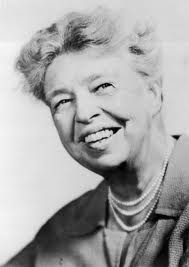Thursday
Dharma TeachingsEleanor: Unbiased at the Root
I recently encountered a wonderful quote on fear and fearlessness from Eleanor Roosevelt, which got me thinking about people who are Shambhalian at the core of their beings without ever having encountered the teachings specifically. As we know from the Shambhala teachings, all human beings are motivated by unconditional basic goodness. That basic goodness is utterly free from doctrine, gender, social status, sexual preference, and so forth – it is utterly free.
The Shambhala teachings also show us that we can notice what we are doing from the tiniest detail to the most complex and overwhelmingly difficult situation. Every moment offers us a fresh opportunity to act with wakefulness. Our meditation practice provides a stable foundation for being in the world and provokes sparkling insight. We develop the eyes of dharma so we can see and feel how we can continuously flow with what we encounter. Based on this evolving sense of insight we begin to see how we act out in fear and reject the message of basic goodness or we embrace that message and act from profound kindness and fearlessness. We discover we can develop ourselves as genuine warriors in the world.
The first chapter of Shambhala the Sacred Path of the Warrior is called Creating Enlightened Society. It begins by saying:
The Shambhala teachings are founded on the premise that there is basic human wisdom that can help solve the world’s problems. This wisdom does not belong to any one culture or religion, nor does it come only from the West of the East. Rather, it is a tradition of human warriorship that has existed in many cultures at many times throughout history. (pg 25)
The essential point of this is that human beings and the society we create together arise from unconditional mind, which is like a mirror – able to clearly accommodate and reflect anything and everything. In other words, everything is unbiased at the root. This is the ground of basic goodness. The activity that results from that can be based on fear and cowardice or on confidence, beauty and delight. The teachings continue from this point by describing the beings that go towards confusion and the kind of society they create, as well as describing those who choose liberation and the kind of society they create. As we would expect, those who act from cowardice create a society full of warfare and hatred. Those who choose confidence and compassion create a society that is uplifted and full of dignity, able to deal with all manner of difficult situations and people without aggression.
These teachings might seem like some bizarre Shambhala creation myth that doesn’t really have much relevance to us in our world today. Or we could understand it as a description of how the mind arises from its inherent nature of basic goodness and becomes manifest in the world. Every moment has the potential for creating a relationship based on fear and cowardice or one based on daringness and confidence. This is also how human society arises and how we collectively foster actions that propagate an atmosphere of goodness and delight or one of fear and paranoia. In some sense we create our world over and over again. The beauty of this is that each moment is freshly potent and rich with choice. As we know, on any given day we move through situations where we make good choices followed by ones inspired by confusion, doubt and conflicting emotions. Our meditation practice is our weapon of choice. Can we cultivate flexibility, gentleness and wisdom – or not?
This circles us back to Eleanor Roosevelt. Recently a colleague of mine at work began including a quote from Eleanor Roosevelt in her email signature. Although we have never met face-to-face we have become good friends over the years and even though I don’t know exactly what’s going on in her personal life, I sense that she has recently suffered through a tragedy and it seems so relevant that this particular approach would strike her.
Eleanor Roosevelt says:
“We gain strength, and courage, and confidence by each experience in which we really stop to look fear in the face… we must do that which we think we cannot.”
Obviously this resonates with the Shambhala teachings on confidence and warriorship. This quote intrigued me to learn more about Mrs. Roosevelt, who seemingly lived life inspired by the sun of basic goodness rather than tangled and trapped in the cocoon of fear.
 Eleanor Roosevelt was born to wealth with an elite social status. Her mother died when she was a child and her father allegedly drank himself to death shortly after that. She was regarded as an ugly duckling, orphaned at a young age and shunned by her socially elite family. She may have been deeply wounded by these things, but if so, perhaps it inspired her to be intensely curious about people and to help and support those whose human rights were compromised or even non-existent. She worked to change those circumstances and succeeded in bringing change during and after the Great Depression to many of those who suffered most from poverty, discrimination and unthinkably horrible working conditions.
Eleanor Roosevelt was born to wealth with an elite social status. Her mother died when she was a child and her father allegedly drank himself to death shortly after that. She was regarded as an ugly duckling, orphaned at a young age and shunned by her socially elite family. She may have been deeply wounded by these things, but if so, perhaps it inspired her to be intensely curious about people and to help and support those whose human rights were compromised or even non-existent. She worked to change those circumstances and succeeded in bringing change during and after the Great Depression to many of those who suffered most from poverty, discrimination and unthinkably horrible working conditions.
She actually said that working with others brought more confidence and happiness than focusing on herself. That sounds like a familiar teaching! It is said she was extremely shy and had to work hard to speak and act in public. She wanted to overcome her personal obstacles because her need to accomplish social change was more important than her fear. She went on to marry President Franklin Delano Roosevelt and transformed the role of First Lady by becoming an active participant in the forefront of the political arena. She had a strong influence on many of FDR’s initiatives. She traveled in the Pacific war zone during World War II inspiring and cheering up the U.S. troops. Her crowning achievement was in the United Nations where she is credited as one of the most influential and innovative forces in the writing of the Universal Declaration of Human Rights. That declaration, to my view, is a model for Shambhala ethics and decorum.
She seems to me to exemplify so many of the qualities of warriorship by tirelessly working with difficult life situations and at the same time loving life and embracing it wholeheartedly. Her husband allegedly had several affairs over the years, and died in the company a longtime woman friend, not his wife. She lived in a society that had no idea how to relate to and accept a woman in a powerful role. She is even said to have been the subject of one of J. Edgar Hoover’s secret files in which he allegedly kept evidence of her intimate relationships with other women. She dared to be her own person and to work unrelentingly for the benefit of others. When she was nearing the end of her life she said that even though so much continued to interest her and provoke her curiosity every minute of every day, she had to slow down – at least a little bit.
Life lived in the beam of basic goodness with a radiant smile, kindness and unwavering toughness in the face of opposition equals warriorship. Take a look at a video or photograph of Mrs. Roosevelt and you can see the so-called ugly duckling with a warrior’s brilliant, gentle smile, not afraid or intimidated by her world and able to accomplish so much good for humanity as a result. I aspire to accomplish one small iota of what she did and to do what I think I cannot.
The Sakyong is urging us to live our lives in such a way. My aspiration is that we can all join him in accomplishing the vision of the Great Eastern Sun.
~~
 Shastri Diana Evans has been a Shambhala Buddhist practitioner and teacher for over 35 years. She was a senior staff member and teacher at Shambhala Mountain Center and then the Director of Practice and Education at Shambhala International for many years under the direction of Sakyong Mipham Rinpoche. She has led residential retreats and taught at the Vajradhatu Seminaries as well as teaching and leading training programs in Shambhala Centers in the US and Canada. She practices contemplative photography and Chinese brush painting. After teaching English and traveling in China she returned to Boston in 2005 where she currently lives and works.
Shastri Diana Evans has been a Shambhala Buddhist practitioner and teacher for over 35 years. She was a senior staff member and teacher at Shambhala Mountain Center and then the Director of Practice and Education at Shambhala International for many years under the direction of Sakyong Mipham Rinpoche. She has led residential retreats and taught at the Vajradhatu Seminaries as well as teaching and leading training programs in Shambhala Centers in the US and Canada. She practices contemplative photography and Chinese brush painting. After teaching English and traveling in China she returned to Boston in 2005 where she currently lives and works.
~~
Shastri Column:
2020 Vision Starts Now
Ordinary Bravery
The Summer of Basic Goodness
Discovering Basic Goodness Through Conversation






Mar 23, 2012
Reply
Great article, Shastri Evans !! I appreciate the quality of noticing how warriorship arises in secular life. I identified with your view in the statement, “She seems to me to exemplify so many of the qualities of warriorship by tirelessly working with difficult life situations and at the same time loving life and embracing it wholeheartedly.” Bringing relief to difficult situations can be a very powerful experience in a warrior’s development…it really puts the view to the test.
Mar 15, 2012
Reply
Wonderful article Diana,.
Now we need one on Mandela!!
Mar 15, 2012
Reply
Thank you Diana for this inspiring article.
Mar 15, 2012
Reply
Thanks, Diana – I love your article and am inspired by Eleanor. This is a great story to share with everyone – way beyond just our Shambhala community.
Mar 12, 2012
Reply
Excellent piece Shastri Diana!
Mar 8, 2012
Reply
At Warrior’s Assembly 2000 at KCL, director Johanna Demetrakas included Eleanor Roosevelt as one of her heroes – as someone who exemplified Shambhalian values. I remember Johanna asking us what the world might be like if we could implement Eleanor Roosevelt’s teacher-student ratio recommendation of one teacher to five students. What a wonderful world it could be!
Mar 8, 2012
Reply
Great Article Diana,
Thanks
Benoît